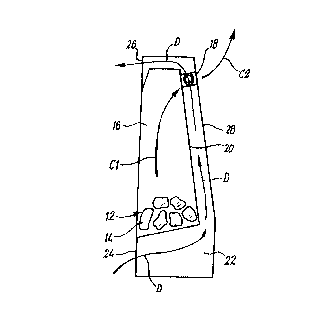Some of the information on this Web page has been provided by external sources. The Government of Canada is not responsible for the accuracy, reliability or currency of the information supplied by external sources. Users wishing to rely upon this information should consult directly with the source of the information. Content provided by external sources is not subject to official languages, privacy and accessibility requirements.
Any discrepancies in the text and image of the Claims and Abstract are due to differing posting times. Text of the Claims and Abstract are posted:
| (12) Patent Application: | (11) CA 2244845 |
|---|---|
| (54) English Title: | IMPROVEMENTS IN OR RELATING TO FIRE ASSEMBLIES |
| (54) French Title: | AMELIORATIONS DE RADIATEURS A GAZ |
| Status: | Deemed Abandoned and Beyond the Period of Reinstatement - Pending Response to Notice of Disregarded Communication |
| (51) International Patent Classification (IPC): |
|
|---|---|
| (72) Inventors : |
|
| (73) Owners : |
|
| (71) Applicants : |
|
| (74) Agent: | RICHES, MCKENZIE & HERBERT LLP |
| (74) Associate agent: | |
| (45) Issued: | |
| (86) PCT Filing Date: | 1997-02-04 |
| (87) Open to Public Inspection: | 1997-08-14 |
| Availability of licence: | N/A |
| Dedicated to the Public: | N/A |
| (25) Language of filing: | English |
| Patent Cooperation Treaty (PCT): | Yes |
|---|---|
| (86) PCT Filing Number: | PCT/GB1997/000310 |
| (87) International Publication Number: | WO 1997029327 |
| (85) National Entry: | 1998-07-29 |
| (30) Application Priority Data: | ||||||
|---|---|---|---|---|---|---|
|
Gas fire assembly (10) comprising a turbine (32) rotatably mounted in a first
conduit (18) through which exhaust gases pass. The turbine (32) is drivably
connected to freely rotatable fans (40, 42) located in a second conduit
located immediately behind the gas burner (12), such that convected air is
warmed in the second conduit (22) and pulled therethrough by the fans (40, 42)
to push convected air into a room space.
L'invention concerne un radiateur à gaz (10). Ce radiateur comprend une turbine (32) montée rotative dans une première conduite (18) à travers laquelle passent les gaz d'échappement. La turbine (32) est reliée, en vue de son entraînement, à des ventilateurs tournant librement (40, 42) placés dans une deuxième conduite située immédiatement derrière le bec de gaz (12). Ainsi, l'air convecté est chauffé dans la deuxième conduite (22) et aspiré dans cette dernière par les ventilateurs (40, 42) pour pousser l'air convecté dans l'espace de la pièce.
Note: Claims are shown in the official language in which they were submitted.
Note: Descriptions are shown in the official language in which they were submitted.

2024-08-01:As part of the Next Generation Patents (NGP) transition, the Canadian Patents Database (CPD) now contains a more detailed Event History, which replicates the Event Log of our new back-office solution.
Please note that "Inactive:" events refers to events no longer in use in our new back-office solution.
For a clearer understanding of the status of the application/patent presented on this page, the site Disclaimer , as well as the definitions for Patent , Event History , Maintenance Fee and Payment History should be consulted.
| Description | Date |
|---|---|
| Inactive: IPC from MCD | 2006-03-12 |
| Application Not Reinstated by Deadline | 2001-02-05 |
| Time Limit for Reversal Expired | 2001-02-05 |
| Deemed Abandoned - Failure to Respond to Maintenance Fee Notice | 2000-02-04 |
| Inactive: Single transfer | 1998-12-04 |
| Inactive: First IPC assigned | 1998-11-07 |
| Classification Modified | 1998-11-07 |
| Inactive: IPC assigned | 1998-11-07 |
| Inactive: IPC assigned | 1998-11-07 |
| Inactive: Courtesy letter - Evidence | 1998-10-13 |
| Inactive: Notice - National entry - No RFE | 1998-10-10 |
| Application Received - PCT | 1998-10-05 |
| Application Published (Open to Public Inspection) | 1997-08-14 |
| Abandonment Date | Reason | Reinstatement Date |
|---|---|---|
| 2000-02-04 |
The last payment was received on 1998-07-29
Note : If the full payment has not been received on or before the date indicated, a further fee may be required which may be one of the following
Please refer to the CIPO Patent Fees web page to see all current fee amounts.
| Fee Type | Anniversary Year | Due Date | Paid Date |
|---|---|---|---|
| Registration of a document | 1998-07-29 | ||
| MF (application, 2nd anniv.) - small | 02 | 1999-02-04 | 1998-07-29 |
| Basic national fee - small | 1998-07-29 |
Note: Records showing the ownership history in alphabetical order.
| Current Owners on Record |
|---|
| KINDER FIRES LIMITED |
| Past Owners on Record |
|---|
| JOHN MICHAEL KINDER |
| MICHAEL JOHN GREEN |